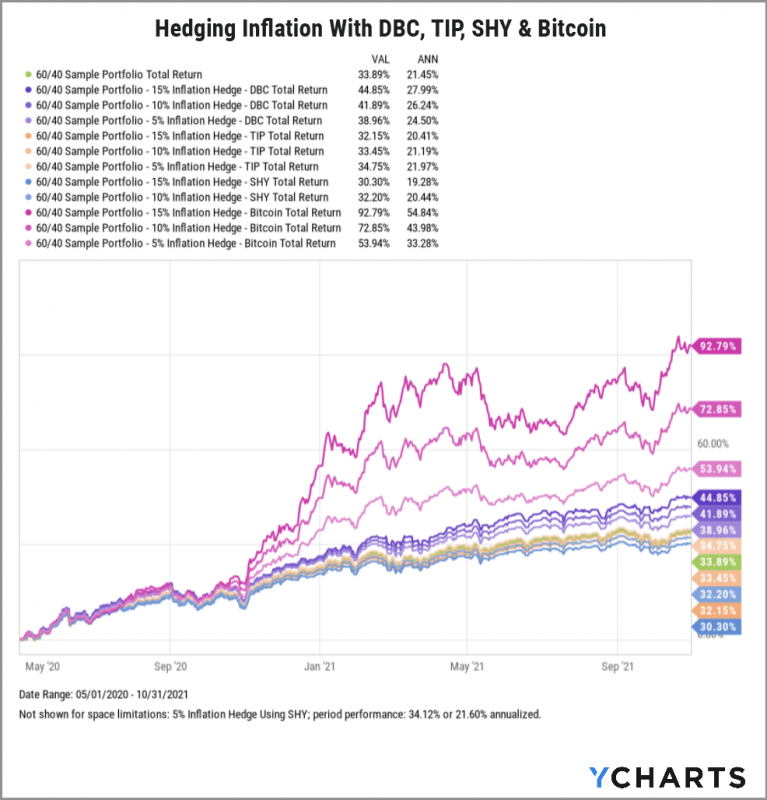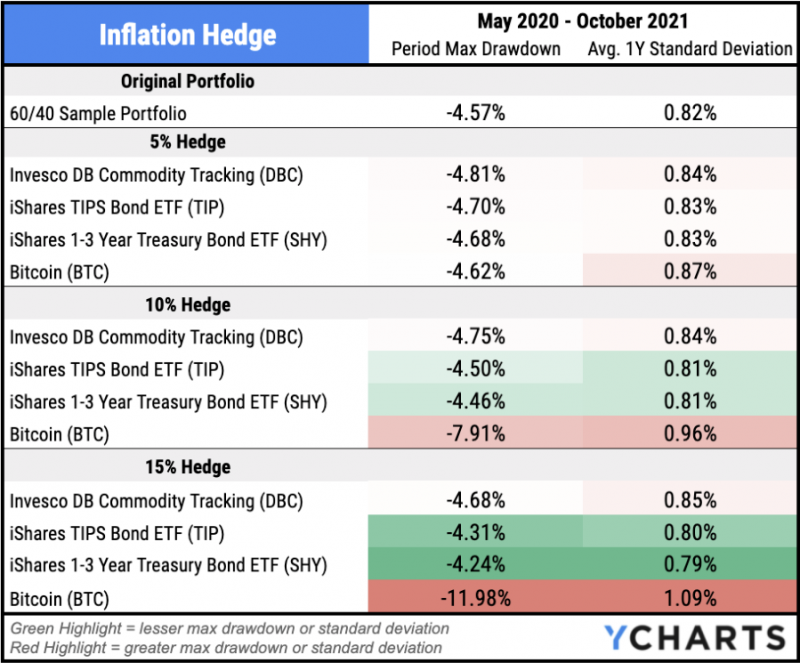Can You Hedge Inflation with an ETF? Or Bitcoin?
In the second week of 2022, the US inflation rate set a 40-year high of 7%.
Not only are you seeing higher prices at the checkout counter and the car dealership, but inflation can take a toll on your investment portfolios as well. Rising costs eat away at corporate profits, income dries up, and the market value of bond investments can decline when inflation is on the rise.
To protect against inflation, investors and advisors often turn to instruments such as short-duration bonds, Treasury Inflation-Protected Securities (TIPS), and commodities. And now, cryptocurrencies like Bitcoin have been suggested as a hedge against inflation due to their finite supply.
So what are the best ways to inflation-proof your portfolio? Will a low-overhead ETF do the trick for implementing an inflation hedge? And, are there any merits to the Bitcoin argument? To better answer these questions, we examined how different hedging strategies performed during historically significant periods. Our findings shed light on the potential benefits and drawbacks of hedging with ETFs and cryptoassets, when added to a hypothetical balanced portfolio of 60% equity, 40% fixed income.
Download the new White Paper—which also looks into hedging volatility, market crashes, geopolitical risk, and climate change using ETFs—for our full findings:
The Best Inflation Hedges in 2020 and 2021
Our full Can You Hedge It with an ETF? white paper uses three distinct periods of rising inflation to measure the efficacy of hedging with several ETFs and Bitcoin. Here, we focus on the most recent and current inflation spike.
The 60/40 Sample Portfolio returned 33.9% in the period from May 2020 through October 2021—when inflation began to rise rapidly. Adding Bitcoin for that same timeframe boosted the portfolio’s performance significantly, adding 20.1, 39, and 58.9 points using BTC weights of 5%, 10%, and 15% respectively. Hedging with commodities (Invesco DB Commodity Tracking ETF – DBC) also provided a lift across all three weights, while taking on larger short-term bond (iShares 1-3 Year Treasury Bond ETF – SHY) or TIPS positions (iShares TIPS Bond ETF – TIP) caused the portfolio to lag.

Download Visual | See the Full White Paper
But, return does not come without its counterpart of risk. During the period, the 60/40 Sample Portfolio saw a max drawdown of 4.6% and standard deviation of 0.82%. A 10% hedge of Bitcoin translated to an additional 3.3 points of drawdown, while a 15% BTC hedge caused max drawdown to worsen by 2.5X compared to the 60/40 Sample Portfolio.
Though a laggard in terms of upside, a 15% hedge of the iShares 1-3 Year Treasury Bond ETF provided the greatest downside protection, cutting the max drawdown by 30 basis points compared to the un-hedged 60/40 Sample Portfolio, and reducing standard deviation by 3 basis points.
One might argue a 5% hedge of Bitcoin brought the most optimal risk/return to the 60/40 Sample Portfolio in this time period, raising the period performance from 33.9% to 53.9% while only marginally worsening the risk metrics.

Download Visual | See the Full White Paper
To see whether ETF and Bitcoin hedges were effective during the other two historical periods of significant inflation—and if ETFs can be used to hedge other risk factors such as volatility, a stock market crash, or weakening US Dollar—download the FREE white paper:
Connect With YCharts
To get in touch, contact YCharts via email at hello@ycharts.com or by phone at (866) 965-7552
Interested in adding YCharts to your technology stack? Sign up for a 7-Day Free Trial.
Disclaimer
©2022 YCharts, Inc. All Rights Reserved. YCharts, Inc. (“YCharts”) is not registered with the U.S. Securities and Exchange Commission (or with the securities regulatory authority or body of any state or any other jurisdiction) as an investment adviser, broker-dealer or in any other capacity, and does not purport to provide investment advice or make investment recommendations. This report has been generated through application of the analytical tools and data provided through ycharts.com and is intended solely to assist you or your investment or other adviser(s) in conducting investment research. You should not construe this report as an offer to buy or sell, as a solicitation of an offer to buy or sell, or as a recommendation to buy, sell, hold or trade, any security or other financial instrument. For further information regarding your use of this report, please go to: ycharts.com/about/disclosure
Next Article
Ben Carlson’s Favorite Charts of 2021Read More →
